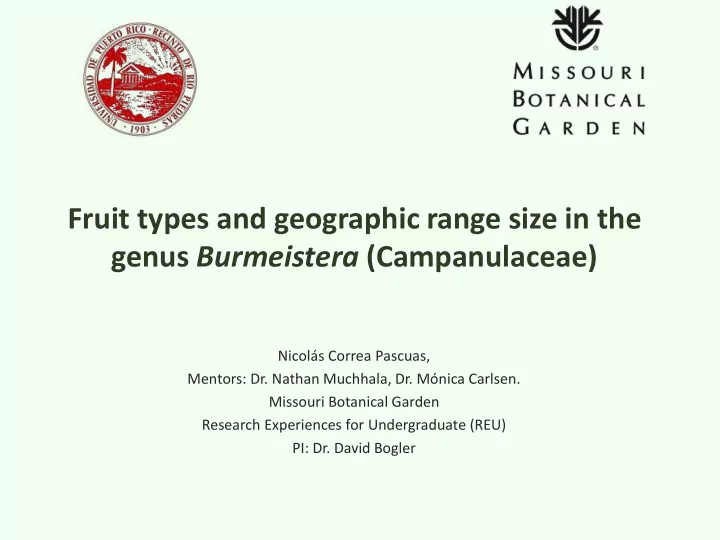

Fruit types and geographic range size in the genus Burmeistera (Campanulaceae) Nicolás Correa Pascuas, Mentors: Dr. Nathan Muchhala, Dr. Mónica Carlsen. Missouri Botanical Garden Research Experiences for Undergraduate (REU) PI: Dr. David Bogler
Introduction • Geographic range size is one of the fundamental ecological and evolutionary characteristics of species. • Range sizes are influenced by several abiotic and biotic conditions, among those: dispersal ability • Plants with flying-animal dispersal agents tend to have larger distribution ranges. The goal of this project is to examine how dispersal agents may influence geographic range sizes in the genus Burmeistera spp.
Target species • Burmeistera spp. (Campanulaceae) • 117 species • Montane cloud forest 1000- 3000m elevation • Pollinated by bats and birds • Two types of fruits B. ceratocarpa B. parviflora Anoura geoffroyi and B. sodiroana Photo credits: www.umsl.edu/~muchhalan/Bat_Flower_Pix.html
Fruit types 1) Brightly-colored, fleshy cylinders, non-inflated fruits or berries which appear to be adapted to bird dispersal B. smaragdi B. succulenta Burmeistera cyclostigmat a Fieldmuseum neotropical live plant: http://fm2.fieldmuseum.org/ OTS Herbaria (ots.ac.cr), Garzón & Gonzales (2012)
Fruit types 2) Dull-green, inflated ‘ balloons ’ with the seeds held in a ball. Some sort of a mystery in dispersal terms. Perhaps dispersed by ants or rodents B. glabrata Burmeistera vulgaris Burmeistera spp Bailey Hortorium.http://tcf.bh.cornell.edu/ Photo: TROPICOS.org
Research questions •Do non -inflated fruits (i.e. berries) have larger geographic range sizes than those with inflated fruits? • Which are the climatic conditions influencing the geographic distribution of Burmeistera species in different biogeographic regions?
Methods Fruit measurements: Length and width of the most developed fruit. Fruit type: designated using field observations, herbarium specimens and available literature.
Specimen records: • Geographic occurrence was taken from online databases n=1979 n=1173 n=102 n=3454 unique collection for a total of 97 species
Geographic range sizes estimates 1. Extent of Occurrence (EOO): as area of polygon using GeoCAT (geocat.kew.org) 2. Maxent models (Phillips 2006) with 11 non-correlated bioclimatic variables (Hijmans 2005). • Default settings • 30% random test • Equal training sensitivity and specifity
RESULTS
A comparison of Burmeistera fruit types Burmeistera glauca Inflated fruits are usually bigger than non-inflated (berries)
Geographic range sizes B. cyclostigmata Extent Of Occurrence (EOO) Area of predicted suitability Area= 897,099,292 km 2 Area= 508,662 km 2 Estimates of geographic range sizes for Burmeistera cyclostigmata. Sampling size n=509 (black/blue dots)
Geographic range sizes B. crispiloba Extent Of Occurrence (EOO) Area of predicted suitability Area= 41,339,543 km 2 Area= 305,173km 2 Estimates of geographic range sizes for Burmeistera crispiloba . Sampling size n=25 (black/blue dots)
Comparison between fruit types and geographic ranges p-value= 0.3972 p-value= 0.8878 n=9 n= 7 n=21 n= 31 median= 480,970 km2 median= 362,804 km2 median= 16,913,610 km2 median= 14,423,762 km2 Apparently, there is no relationship between geographic range sizes and fruit types (p>0.05)
Climatic conditions We extracted each BIOCLIM values for all occurrences and divided them into 4 biogeographic regions. DAR (Darién) WDS (Widespread, with specimen records from both continent) SA (South America) CA (Central America) • Species with wider distributions can tolerate a wider gradient of environmental factors than those more restricted • In general, South American species are exposed to higher temperatures and lower precipitation than Central American species
• Environmental conditions in the Darién region might be acting as a dispersal barrier in Burmeistera species. Fig. […] Coloured regions in the main map represent simplified World Wildlife Fund ecoregions (‘ Caribbean WET ’ combines three WWF ecoregions: Central American Atlantic moist, Isthmian-Atlantic moist, and Chocó- Darién moist. ‘Montane’ combines three WWF ecoregions: Central American, Talamancan and Eastern Panamanian montane forests)[..] Crawford et al. ( 2007)
All Burmeistera occurrence points with unique values Total species= 97 Number of points =3454
Conclusions • Geographic range sizes do not seem to differ among species with non-inflated and inflated fruits. • Bioclimatic conditions - temperature and precipitation - vary among biogeographic regions, which in turn may influence the geographic distribution of Burmeistera species within the Neotropics.
Other observations n n i n n i i i n n i i SEM micrographs of Burmeistera seeds
Acknowledgments • Dr. Nathan Muchhala- Mentor • Dr. Mónica Carlsen- Mentor • Dr. David Bogler- REU coordinator • REU students • Missouri Botanical Garden • National Science Foundation
Recommend
More recommend